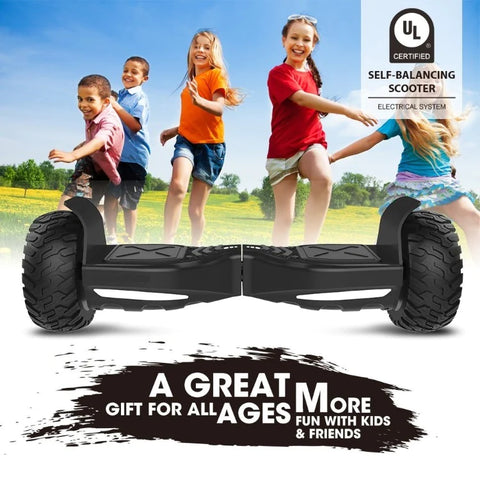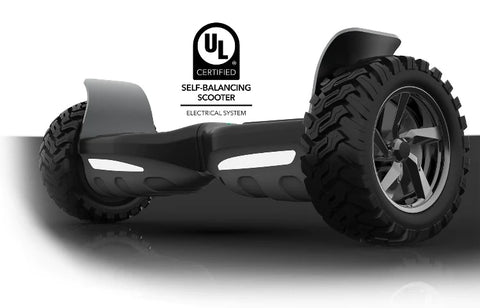
Since the movie "Back to the Future," hoverboards have been in many people's minds. When they finally became a reality, albeit a bit less "hovery" than the film version, they have been rising in popularity ever since. While they share some similarities with electric scooters and skateboards, they are a category all of their own. They both have a footboard and wheels, but the similarities end here.
You've probably seen people zooming by on sidewalks and might be enticed to get your hands on one yourself but don't know where to start because there are many different types of hoverboards. No worries, we've got you covered. Knowing the pros and cons and all the differences before purchasing is essential because you want to choose a hoverboard that matches your needs and preferences.
Welcome to our hoverboard buying guide with everything you need to know!
What is a Hoverboard?
Let's start with the answer to the question of what a hoverboard is in the first place. A hoverboard, a self-balancing scooter, is a two-wheeled, battery-powered device. Despite the name, it doesn't hover like a skateboard from the future might. Instead, it uses gyroscope sensors, microprocessors, and motors to help the rider maintain balance.
The gyroscopic sensors detect changes in tilt and your body position and then send real-time data to the onboard microprocessors, which calculate the required adjustments to maintain balance.
The motors, usually one for each wheel, receive signals from the microprocessors to adjust the speed and direction of the wheels. If you lean forward, the motors move the wheels forward; if you lean backward, the wheels move back. A rechargeable battery, usually lithium-ion, powers the hoverboard to provide the necessary energy to run the motors and electronics.
You stand on foot pads on either side of the device. Applying pressure with your feet, you can control the speed and direction of the hoverboard.
By constantly monitoring and adjusting based on your movements, the hoverboard creates the illusion of being self-balancing. It takes a bit of practice to get the hang of it, but once mastered, it can be a fun and efficient mode of personal transportation.
Types of Hoverboards
As mentioned above, there are a few different types of hoverboards to choose from.
Self-Balancing Hoverboards
These standard two-wheeled hoverboards use gyroscopic sensors and accelerometers to maintain balance.
Off-Road Hoverboards
Off-road hoverboards are designed with more robust tires and sturdier construction, suitable for rougher terrains like dirt paths and grass. They sometimes are also called all-terrain hoverboards.
Mini Hoverboards (for Kids)
These are scaled-down versions designed specifically for younger riders. They usually have lower speeds and smaller foot pads.
Hoverboard Scooters
Some models come with a handlebar or a central column, adding a scooter-like element for stability and ease of use.
Hoverboard with Seats
These are a fusion of a hoverboard and a small electric scooter, offering a seated riding experience.
Safety Considerations
Safety should be a top priority when using hoverboards. Here are some essential safety considerations:
UL Certification and Safety Standards
Look for hoverboards that are UL (Underwriters Laboratories) certified. This certification ensures that the product has undergone rigorous electrical and fire safety testing.
Battery Safety and Fire Risks
The most significant safety concern with hoverboards is related to their batteries. Choose a hoverboard with a reputable battery and follow charging guidelines strictly. Overcharging or using non-approved chargers can lead to fire hazards. Keep an eye on the battery during use and charging.
Rider Safety Gear
Always wear appropriate safety gear, including helmets, knee pads, elbow pads, and wrist guards. Falls and collisions can happen, and protective equipment can reduce the risk of injuries.
Riding in Safe Environments
Choose safe and appropriate environments for riding. Avoid busy streets, crowded areas, or places with obstacles. Smooth and flat surfaces are ideal for hoverboard riding. Be cautious near traffic and pedestrian areas.
Training and Practice
Before hitting the streets, spend time practicing in a controlled environment. Get comfortable with the balance and steering of the hoverboard before venturing into more challenging settings.
Age and Weight Limits
Follow the manufacturer's guidelines regarding age and weight limits. Different hoverboards may have varying specifications, and exceeding these limits can affect performance and safety.
Regular Maintenance
Keep your hoverboard in good condition by regularly checking for loose parts, damaged components, or wear and tear. Maintenance ensures that the device functions properly and reduces the risk of accidents.
Awareness of Local Regulations
Be aware of local regulations regarding the use of hoverboards. Some areas may have specific rules or restrictions on where you can ride.
Benefits of Owning a Hoverboard
Hoverboards are a fun, alternative way of transportation, but it's not just about the fun; they also have some other considerable benefits!
Hoverboards are compact and easy to carry, making them a convenient mode of personal transportation. They're particularly handy for short commutes or getting around in crowded areas and also eliminate the need for parking space. Since they are electrically powered, they produce no emissions, contributing to a cleaner and greener environment.
Hoverboards are a source of entertainment and recreation. They offer a unique and enjoyable way to travel short distances while having fun, but they are far more than that. Riding a hoverboard engages core muscles and promotes balance and coordination. While it might not replace a full workout, it adds a bit of physical activity to your routine.
Compared to other personal transportation options, hoverboards are relatively affordable. Once you've made the initial purchase, the cost of operation (electricity for charging) is minimal.
And let's be honest, riding a hoverboard can be a stylish and futuristic way to get around. It adds a modern and tech-savvy touch to your image, and while you're not floating (yet), it's pretty close.
Hoverboard Features to Consider
Hoverboard Size and Weight Capacity
Choosing the right hoverboard size is crucial for a safe and comfortable ride. It's not just about age but also weight. Different models come with varying weight capacity limits, so matching the hoverboard to the rider's weight is essential. This ensures optimal performance and stability, preventing issues related to overloading.
Range and Battery Life
Understanding a hoverboard's range and battery life is critical for planning longer rides. The range indicates how far the hoverboard can travel on a single charge, while battery life refers to the battery's overall lifespan. Factors like terrain, rider weight, and speed can influence both. It's wise to choose a electric hoverboard with a range that suits your typical usage and consider the charging time.
Speed and Maximum Speed
Setting the correct speed is essential, especially for younger or less experienced riders. Many hoverboards allow speed adjustment, ensuring a safer and more controlled ride. Safety considerations should also extend to the maximum speed setting. Riders, particularly beginners, should adhere to recommended speed limits to prevent accidents and maintain overall control.
Bluetooth and Speaker Integration
Bluetooth and speaker integration add a fun and entertaining element to hoverboarding. Riders can enjoy music or podcasts while cruising. However, it's essential to balance entertainment with awareness. Riding in traffic or busy areas requires full attention, so riders should use Bluetooth features responsibly. Additionally, some riders might prefer the simplicity of a quiet ride without distractions.
LED Lights and Aesthetics
LED lights on hoverboards serve practical and aesthetic purposes. They enhance visibility, making riders more noticeable, especially in low-light conditions. Additionally, LED lights contribute to the overall cool factor, allowing riders to express their style. Some hoverboards offer customizable LED options, letting users personalize their ride with different colours and effects. It's a blend of safety and style, simultaneously making the hoverboard experience visually appealing and safe.
How to Choose the Right Hoverboard
When choosing the right hoverboard, there are a couple of factors to consider to make an informed decision and to ensure the board you choose will match your needs and preferences.
Identify Your Needs and Preferences
One major factor to consider is the age and skill level of the rider. Also, consider your intended use. Will you use it for commuting, recreation, or both? The same goes for the terrain: will you stay on smooth pavement, or do you want to explore the great unknown and the grassy plains or gravelly paths?
Set a Budget
Hoverboards come in various price ranges. Set a budget that aligns with your requirements. You should consider not only the initial cost but also potential maintenance and accessory expenses.
Research Customer Reviews and Ratings
Look for reviews from users who share similar needs. Pages like Google can give you firsthand feedback on their experiences.
Pay attention to feedback regarding durability, battery life, and overall performance. Ratings on reliable platforms can provide additional insights into the product's reliability.
Compare Features and Specifications
Consider critical features such as size, weight capacity, range, and speed to determine if they match your needs and requirements. Check for and compare safety features, like LED lights and speed control. Also, compare battery types and charging times.
Test Riding (if possible)
If feasible, test-ride a hoverboard before purchasing to assess how comfortable and easy it is to control. This will also allow you to confirm that the size and weight capacity suits your needs.
Remember, the right hoverboard for you is the one that aligns with your lifestyle, preferences, and safety considerations. It's about more than just the brand or the latest features but how well it meets your requirements.
Conclusion
Hoverboards are a fun way of getting around the area, but it's crucial to consider all factors to make an informed decision. Making an informed hoverboard purchase is smart, and it's fantastic that you're taking the time to consider all the elements. Here's a little encouragement for your decision-making journey:
Choosing the right hoverboard is like finding the perfect adventure companion. It's not just about the specs and features; it's about discovering the one that resonates with your lifestyle and preferences. Think of it as a functional vehicle and an extension of your style and personality.
The effort you put into researching and comparing different models will pay off when you find the hoverboard that ticks all your boxes. Whether for a quick commute, a fun ride with friends, or a futuristic solo journey, your hoverboard should perfectly match your needs.
KingToys is a family-owned online business based in beautiful Ontario, Canada. Our commitment to quality is reflected in our carefully curated selection of hoverboards, all tested for safety and durability.
As a family-owned business, we take pride in our personalized approach to customer service. Our team is always happy to answer any questions and help you find your perfect hoverboard. We want you to feel like part of our family and know you can trust us to provide you with the best products and services possible.
Call us today at 289-440-2555 to learn how we can help you cruise on the best hoverboard in no time!




